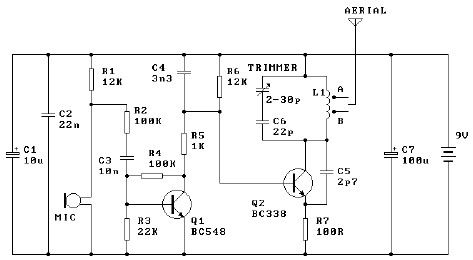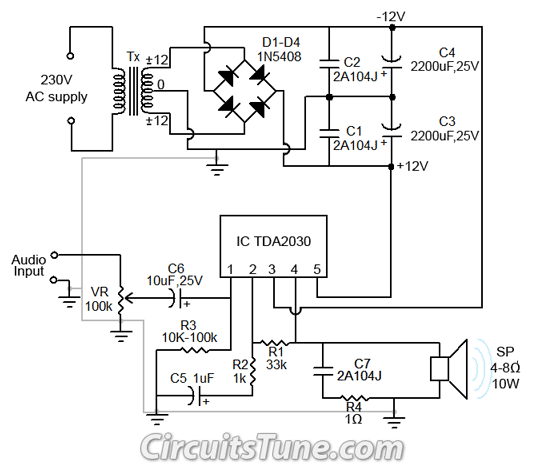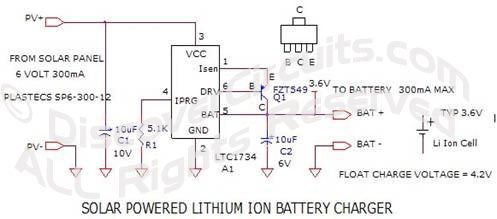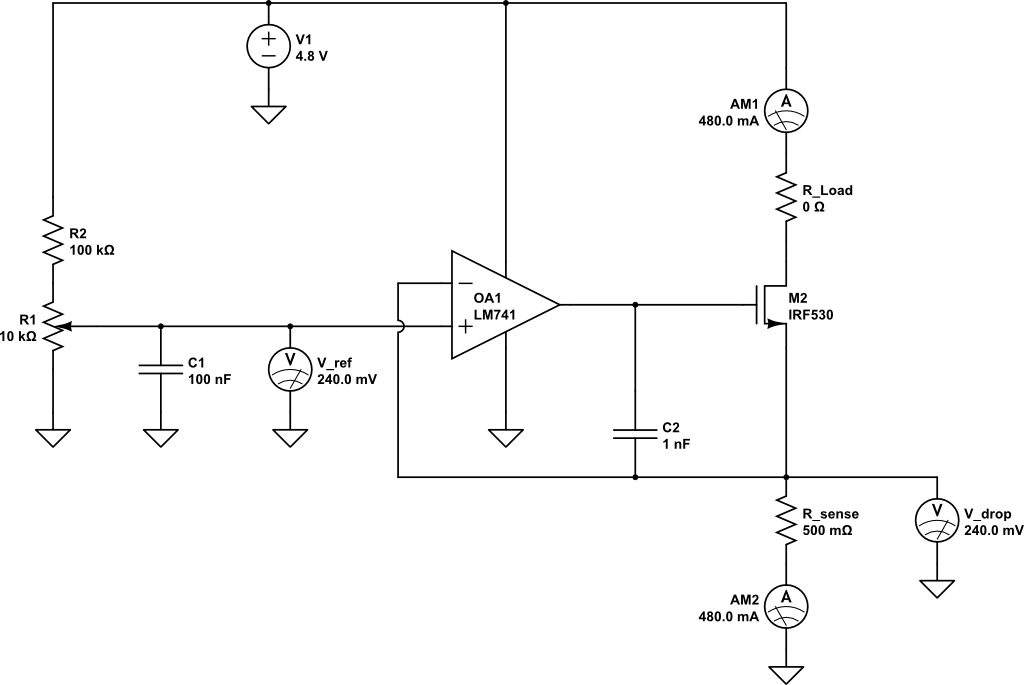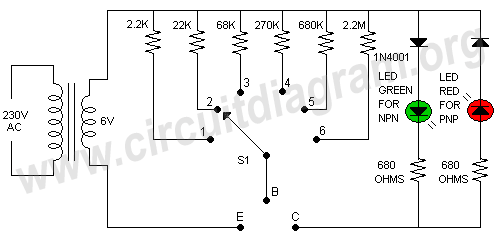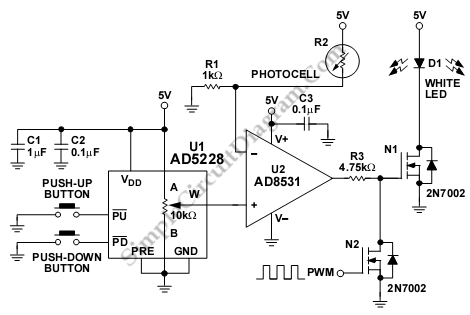
Hi-Fi DX Bass circuit
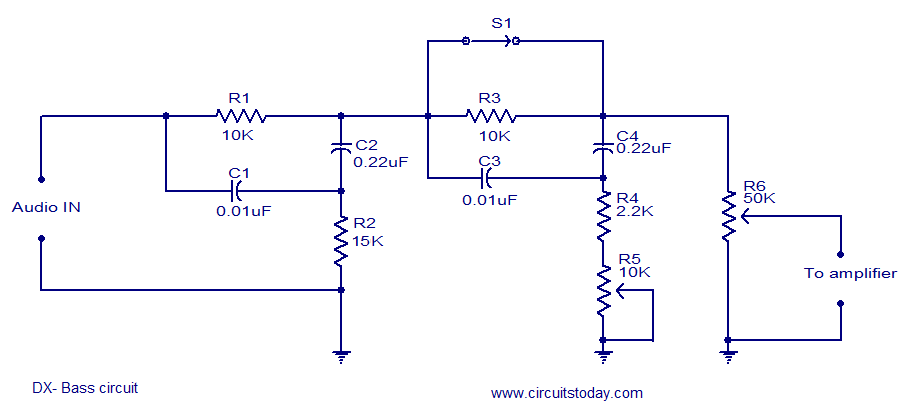
The circuit diagram of a passive DX bass circuit is presented, which is compatible with nearly all audio amplifiers. This design was created by Mr. Emmanuel Chipula from Malawi and submitted for publication. Laboratory tests confirmed satisfactory performance. Credit for this circuit is attributed to Mr. Emmanuel Chipula, who is appreciated for his contribution. Mr. Chipula notes that while the circuit is passive, it can be converted into an active one by adding a preamplifier at the output. The first stage serves as the main tone stage, balancing bass and treble. A 0.01 µF capacitor is used for high frequencies, while a 0.22 µF capacitor is employed for low frequencies. The second stage is dedicated to sound compression, with capacitors functioning similarly to those in the first stage, initiating sound compression from the input stage. A 2.2 kΩ resistor introduces a delay in sound, enhancing the compression effect. A 10 kΩ variable resistor is utilized to adjust the compression based on the speaker's frequency. For 4 to 6-inch hi-fi speakers, it is recommended to set the 10 kΩ variable resistor to 0 ohms. The circuit is not copyrighted, allowing modifications to meet specific needs, with a request to share updates on the circuit design.
The passive DX bass circuit operates by manipulating audio signals to enhance the bass response while maintaining a balanced output across the frequency spectrum. The circuit consists of two main stages: the tone control stage and the compression stage.
In the tone control stage, the 0.01 µF capacitor is strategically placed to filter out high-frequency signals, allowing the lower frequencies to be amplified and balanced with the treble. The 0.22 µF capacitor serves a similar purpose for low frequencies, ensuring that the bass response is pronounced without overwhelming the overall sound quality. This stage is crucial for achieving a desirable sound profile, especially when paired with various audio amplifiers.
The second stage focuses on sound compression, which is essential for managing audio dynamics. The capacitors in this stage are tasked with initiating the compression process, which helps to prevent distortion and maintain clarity at higher volumes. The introduction of the 2.2 kΩ resistor plays a significant role in delaying the sound, effectively multiplying the compression effect. This delay can enhance the perceived richness of the bass, making it more impactful during playback.
The 10 kΩ variable resistor provides flexibility in tuning the circuit to suit different speaker configurations. Adjusting this resistor allows users to optimize the circuit's performance based on the specific frequency response of their speakers. For smaller hi-fi speakers, setting the resistor to 0 ohms minimizes the compression effect, allowing for a more natural sound reproduction.
Overall, the passive DX bass circuit is versatile and user-friendly, making it suitable for a wide range of audio applications. Its design encourages experimentation and adaptation, empowering users to modify the circuit to meet their individual preferences while ensuring high-quality audio output.Here is the circuit diagram of a passive DX bass circuit that can be used with almost all audio amplifiers. This circuit is designed by Mr. Emmanuel Chipula ( emmanuel@windowshoppingmalawi. com ) from Malawi and was sent to us for publication. We tested this circuit in our lab and the result was fine. Full credit of this circuit goes to Mr. Emmanuel C hipula and we thank him for his contribution. Emmanuel`s comments on the circuit : The circuit that I have designed is a passive one but you can make it an active one by adding a pre amp at the output. The first stage acts as a main tone stage. It balances the bass and the treble. The 0. 01 cap is for high frequency while the 0. 22uF cap is for low frequency. The second stage is for sound compression. the caps works the same as at the first stage only that they are there to start the sound compression that is received from the input stage.
The 2. 2k resistor delays the sound thereby multiplying the compression. The 10k variable resistor is there used to tune the compression depending on the frequency of the speaker. If you are using 4 to 6 inches hi-fi speakers, I advise you to keep the 10k variable resistor at 0 ohm.
The circuit is not copyrighted and you can change it to suit your requirement. All I ask is to be posting the updates of the circuit design on the site. 🔗 External reference
The passive DX bass circuit operates by manipulating audio signals to enhance the bass response while maintaining a balanced output across the frequency spectrum. The circuit consists of two main stages: the tone control stage and the compression stage.
In the tone control stage, the 0.01 µF capacitor is strategically placed to filter out high-frequency signals, allowing the lower frequencies to be amplified and balanced with the treble. The 0.22 µF capacitor serves a similar purpose for low frequencies, ensuring that the bass response is pronounced without overwhelming the overall sound quality. This stage is crucial for achieving a desirable sound profile, especially when paired with various audio amplifiers.
The second stage focuses on sound compression, which is essential for managing audio dynamics. The capacitors in this stage are tasked with initiating the compression process, which helps to prevent distortion and maintain clarity at higher volumes. The introduction of the 2.2 kΩ resistor plays a significant role in delaying the sound, effectively multiplying the compression effect. This delay can enhance the perceived richness of the bass, making it more impactful during playback.
The 10 kΩ variable resistor provides flexibility in tuning the circuit to suit different speaker configurations. Adjusting this resistor allows users to optimize the circuit's performance based on the specific frequency response of their speakers. For smaller hi-fi speakers, setting the resistor to 0 ohms minimizes the compression effect, allowing for a more natural sound reproduction.
Overall, the passive DX bass circuit is versatile and user-friendly, making it suitable for a wide range of audio applications. Its design encourages experimentation and adaptation, empowering users to modify the circuit to meet their individual preferences while ensuring high-quality audio output.Here is the circuit diagram of a passive DX bass circuit that can be used with almost all audio amplifiers. This circuit is designed by Mr. Emmanuel Chipula ( emmanuel@windowshoppingmalawi. com ) from Malawi and was sent to us for publication. We tested this circuit in our lab and the result was fine. Full credit of this circuit goes to Mr. Emmanuel C hipula and we thank him for his contribution. Emmanuel`s comments on the circuit : The circuit that I have designed is a passive one but you can make it an active one by adding a pre amp at the output. The first stage acts as a main tone stage. It balances the bass and the treble. The 0. 01 cap is for high frequency while the 0. 22uF cap is for low frequency. The second stage is for sound compression. the caps works the same as at the first stage only that they are there to start the sound compression that is received from the input stage.
The 2. 2k resistor delays the sound thereby multiplying the compression. The 10k variable resistor is there used to tune the compression depending on the frequency of the speaker. If you are using 4 to 6 inches hi-fi speakers, I advise you to keep the 10k variable resistor at 0 ohm.
The circuit is not copyrighted and you can change it to suit your requirement. All I ask is to be posting the updates of the circuit design on the site. 🔗 External reference
